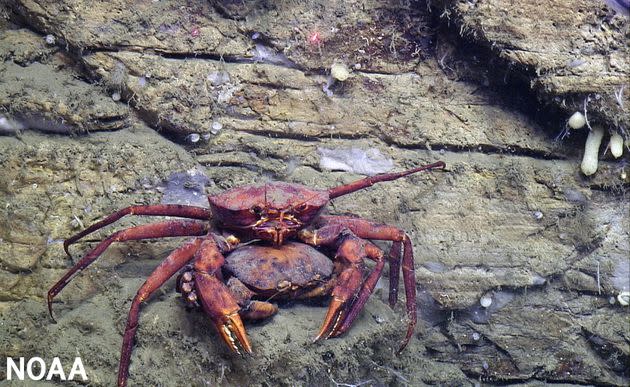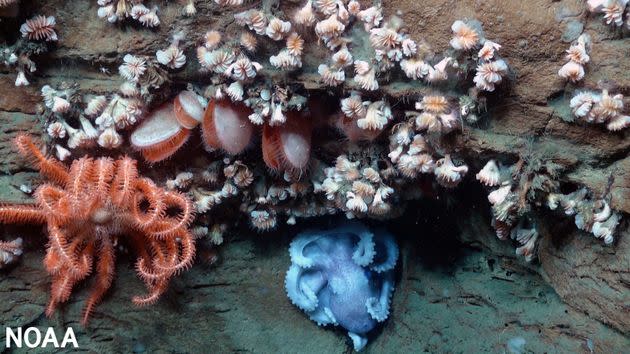U.S. Proposes New Marine Sanctuary Off New York, Home To Sperm Whales And Sea Turtles
The Biden administration proposed a new marine sanctuary off the coast of New York on Wednesday and said it would move to ban the sale of single-use plastics from all public lands over the next decade.
The White House said the measures, a slate of environmental moves announced on World Oceans Day, would help “conserve and restore the health and productivity of the ocean for the benefit of all Americans.”
The proposed national marine sanctuary would encompass the Hudson Canyon, a deep underwater valley that lies about 100 miles off the coast of New York and New Jersey. The canyon, one of the largest in the world, is up to 2.5 miles deep in parts and provides habitat for sperm whales, sea turtles, octopuses and deep sea corals.

A pair of mating deep-sea red crabs rests on a ledge of a canyon wall in Hudson Canyon off the coast of New York and New Jersey. (Photo: NOAA/BOEM/USGS)
The National Oceanic and Atmospheric Administration (NOAA) said it would begin a public comment period on the matter and will then consider what it would be called and what areas it would encompass. The full process, which would also include an environmental impact analysis and management plan, could take more than a year, The Washington Post reported.
“A sanctuary near one of the most densely populated areas of the Northeast U.S. would connect diverse communities across the region to the ocean and the canyon in new and different ways,” NOAA Administrator Rick Spinrad said in a statement. “As someone who grew up in New York City and went on to a career in ocean science, I am excited about how this amazing underwater environment can inspire shared interest in conserving our ocean.”
Announcing: Hudson Canyon National Marine Sanctuary Designation
You are invited to participate in the first step in the process to potentially designate a new national marine sanctuary off the coast of New York and New Jersey, known as Hudson Canyon.https://t.co/YvH6wY053qpic.twitter.com/KRWNOEZ4Ci— Sanctuaries (NOAA) (@sanctuaries) June 8, 2022
The Interior Department also said Wednesday it would move to phase out the sale of single-use plastics on public lands by 2032, which includes national parks. The agency noted that plastic pollution remains a major problem on public lands, adding that less than 10% of the plastic ever produced has been recycled.
“The Interior Department has an obligation to play a leading role in reducing the impact of plastic waste on our ecosystems and our climate,” Interior Secretary Deb Haaland said in a statement. “As the steward of the nation’s public lands, including national parks and national wildlife refuges, and as the agency responsible for the conservation and management of fish, wildlife, plants and their habitats, we are uniquely positioned to do better for our Earth.”
The move was hailed by environmental groups.

An octopus, sea star, bivalves and dozens of cup coral share an overhang in an area adjacent to the Hudson Canyon off the coast of New York and New Jersey. They are typical of the marine life in this area. (Photo: NOAA/BOEM/USGS)
“Our national parks, by definition, are protected areas — ones that Americans have loved for their natural beauty and history for over a century — and yet we have failed to protect them from plastic for far too long,” Christy Leavitt, the plastics campaign director for Oceana, a nonprofit ocean conservation group, said in a statement. “The Department of Interior’s single-use plastic ban will curb millions of pounds of unnecessary disposable plastic in our national parks and other public lands, where it can end up polluting these special areas.”
President Joe Biden campaigned on goals of protecting 30% of America’s lands and waters by 2030, known as the “30 by 30” initiative. Those efforts included rolling back former President Donald Trump’s efforts to dismantle protections for several national monuments, but Biden has also pledged to establish new protected sites to address climate change and safeguard important ecological zones.
This article originally appeared on HuffPost and has been updated.

